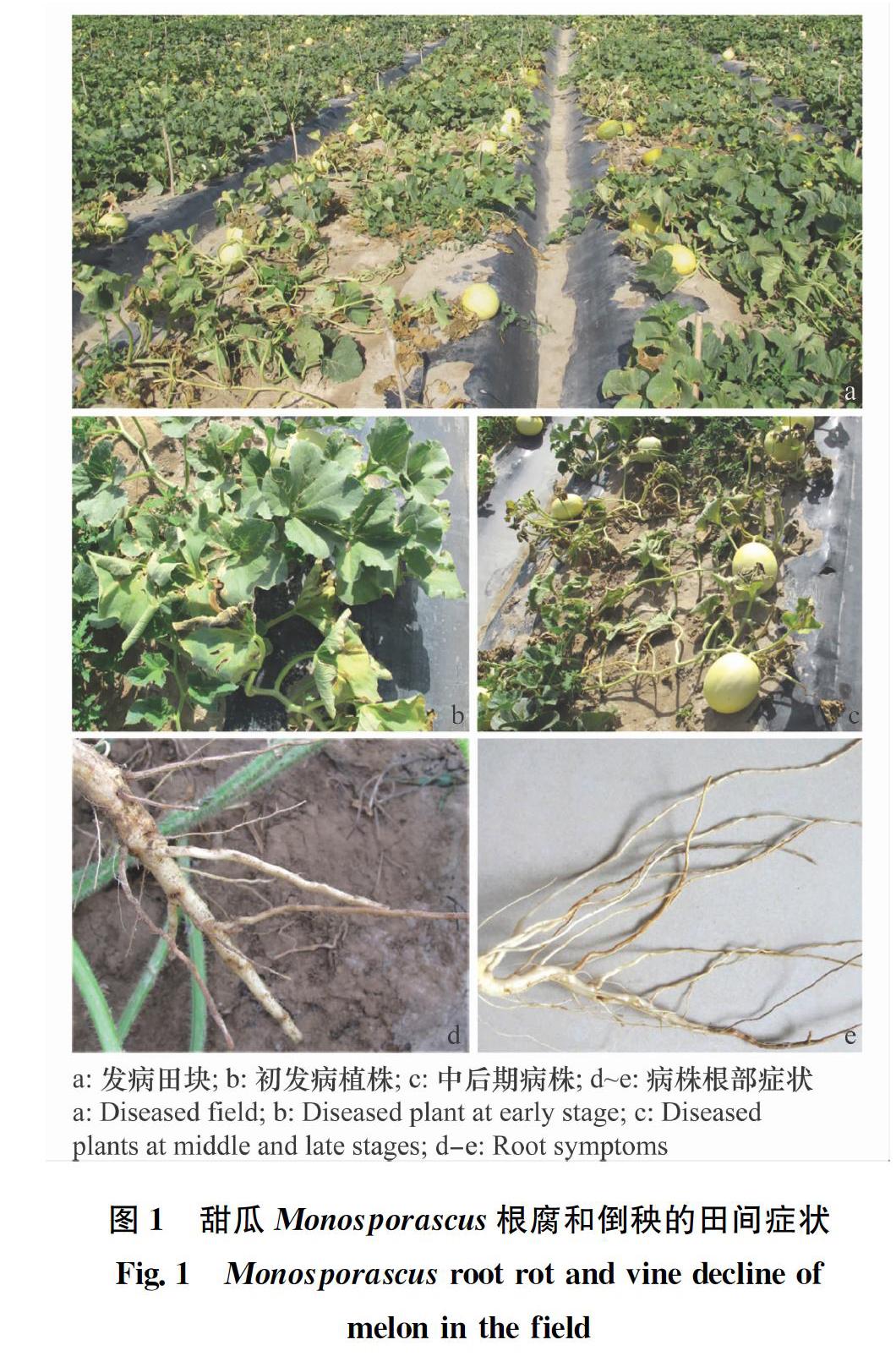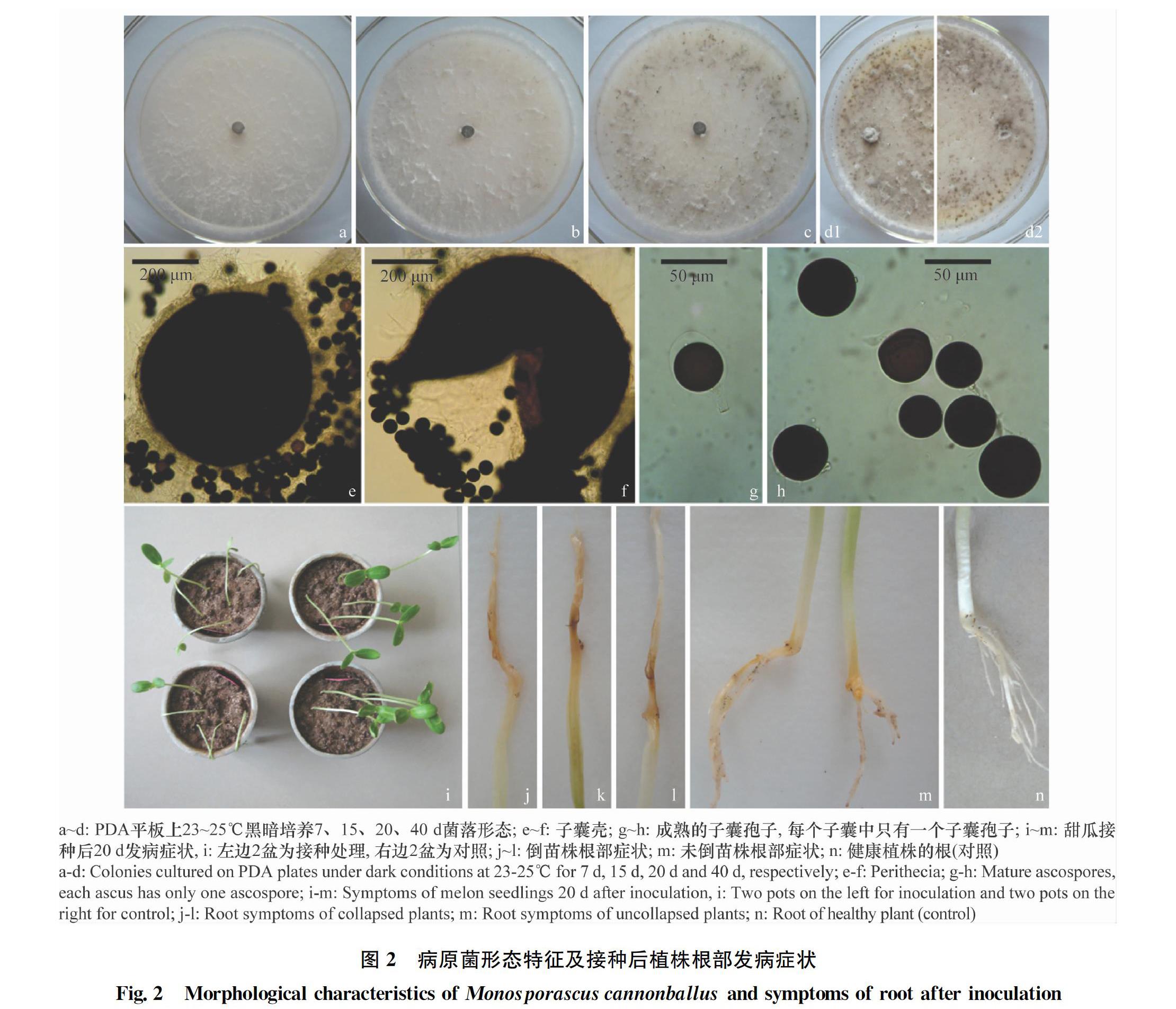甘肅酒泉發現坎諾單孢菌引起的甜瓜倒秧
何蘇琴 白濱 文朝慧 荊卓瓊 孟選寧 徐生軍


摘要 :2018年7月中旬在甘肅省酒泉市金塔縣,甜瓜成熟前10~20 d,一些田塊出現了嚴重的倒秧,從罹病植株的褐腐根上分離到坎諾單孢菌Monosporascus cannonballus,病株分出率達76.9%。致病性測定結果顯示:在試驗條件下(25℃±3℃),菌株TG?84對甜瓜(品種:‘86?1)的致病性強,出苗后13 d,倒苗率達80%。
關鍵詞 :甜瓜;?坎諾單孢菌
中圖分類號:
S 436.5
文獻標識碼:?B
DOI:?10.16688/j.zwbh.2018534
Emergence of melon collapse caused by Monosporascus cannonballus
in Jiuquan region, Gansu province
HE Suqin1,2,?BAI Bin3,4,?WEN Zhaohui5,?JING Zhuoqiong1,2,?MENG Xuanning6,?XU Shengjun1,2
(1. Institute of Plant Protection, Gansu Academy of Agricultural Sciences, Lanzhou?730070, China; 2. Scientific
Observing and Experimental Station of Crop Pests in Tianshui, Ministry of Agriculture, Tianshui?741200, China;
3. Institute of Agricultural Quality Standards and Testing Technology, Gansu Academy of Agricultural Sciences,
Lanzhou?730070, China; 4. Laboratory of Quality & Safety Risk Assessment for Agro?Products, Ministry
of Agriculture, Lanzhou?730070, China; 5. Comprehensive Technical Center of Gansu Entry?Exit Inspection and
Quarantine Bureau, Lanzhou?730020, China; 6. Jiuquan Institute of Agricultural Sciences in Gansu, Jiuquan?735000, China)
Abstract
In mid?July of 2018, severe melon root rot and vine decline broke out in some plots 10-20 days before melon maturity in Jinta county, Jiuquan city, Gansu province. Monosporascus cannonballus was isolated from diseased roots with an isolation rate of 76.9%. The pathogenicity test showed that the strain TG?84 had aggressive virulence to melon (variety: ‘86?1), with a seedling collapse rate of 80% 13 days after emergence under the test conditions (25℃±3℃).
Key words
melon;?Monosporascus cannonballus
由坎諾單孢菌Monosporascus cannonballus引起的甜瓜黑點根腐病亦被稱作倒秧(melon collapse)、突然枯萎(sudden wilt)、根腐(root rot)、敗藤(vine decline)及根腐和敗藤(root rot and vine decline),是全球范圍內干旱、半干旱甜瓜種植區的毀滅性病害[12]。病害的癥狀特點主要是甜瓜植株在收獲前10~14 d突然凋萎,病株的根部可見褐色壞疽斑或褐腐根,有時可見生于病根上的凸起的黑色子囊殼;病害造成的損失率約為10%~25%,個別田塊可達100%[1]。
繼2005年7月中旬在蘭州市[3]和2009年8月上旬在武威市(未報道)從罹病的甜瓜根上分離到坎諾單孢菌之后,2018年7月下旬從甘肅省酒泉市金塔縣的甜瓜倒秧株病根上再次分離到該菌,病株分出率達76.9%。
1?材料與方法
1.1?病害標樣采集
2018年7月25日,從甘肅省酒泉市金塔縣采集地上部表現不同程度凋萎癥狀的甜瓜病株13株,將病株的根帶回實驗室(蘭州),用于病原菌分離(圖1)。
1.2?培養基及配方
PDA:馬鈴薯200 g,葡萄糖20 g,瓊脂粉12 g,自來水1 000 mL。
1.3?病原菌分離
以病株為單位,采用組織分離法進行病原菌的分離。依據病株的受害情況,每病株取明顯變色的病組織5~15塊(長度約5~10 mm),經75%乙醇表面消毒5~10 s,滅菌水沖洗4次,置PDA平板上25℃黑暗培養,及時挑取菌落尖端菌絲進行純化,純化后的菌株接種于PDA平板23~25℃黑暗培養至60 d,觀察產孢情況。選其中的TG?84為代表菌株用于后續的試驗。
1.4?致病性測定
菌株TG?84預先在PDA平板上,23~25℃培養20 d,取甜瓜(品種:‘86?1)種子100粒,55℃溫湯浸種后,置于30℃溫箱內催芽,約24 h后,挑選胚根長10 mm左右的發芽種子播種于盛有滅菌營養土的小花盆中(直徑11.5 cm,高7 cm);
將直徑5 mm的菌絲塊,貼接于發芽種子的胚根上,每粒發芽種子接種1枚菌絲塊,接菌后覆土(覆土厚度約2 cm),以接種直徑5 mm的無菌PDA培養基塊為對照。共處理4盆,每盆5粒種子;常規管理,試驗期間溫度(25±3)℃。20 d后挖出所有試驗處理植株,洗根、調查發病率,并取10株發病植株進行病原菌的重分離。
2?結果與分析
2.1?病原菌形態特征
菌株TG?84在PDA平板上于23~25℃條件下黑暗培養。菌落初無色,漸呈淡褐或灰褐色;氣生菌絲稀疏或在菌落邊緣稍豐茂;培養20 d左右開始產生子囊殼;培養60 d左右子囊殼成熟;子囊殼均勻散生,菌落邊緣稍密集;子囊殼初白色,成熟時黑色,球形,408.0~588.0 μm;每個子囊中僅產生一個子囊孢子,子囊壁易消解;子囊孢子球形或近球形,初無色或淡褐色,成熟時深褐色至黑色,32.8~47.2 μm(圖2a~h)。
菌株TG?84的形態特征與文獻描述[4]基本一致,故將其鑒定為坎諾單孢菌M.cannonballus Pollack & Uecker。
2.2?病原菌分離結果
從13個病株樣品中共分離得到24株具有M.cannonballus典型形態特征的菌株。13個病株中有10個病株的罹病根組織上分離到M.cannonballus,病株分出率達76.9%。
2.3?分離菌株的致病性
菌株TG?84對供試的甜瓜品種具有強的致病性。接種后14 d(出苗后7 d)開始出現倒苗株;接種后20 d(出苗后13 d),倒苗株數增加至16株,倒苗率達80%,洗根檢查發現,甜瓜根被侵染率達100%,受害根呈黃褐色至深褐色。對照未發病。發病株原接種菌的分出率達100%(圖2i~n)。
3?討論
在我們的數次調查中,并沒有在罹病甜瓜的病根上看到M.cannonballus的黑點狀子囊殼和子囊孢子,這可能是不同地域的自然條件和栽培模式不同所造成的癥狀差異。
M.cannonballus所具有的獨特的形態特征易于識別和準確鑒定:我們2005年分離鑒定的2個菌株[3],其rDNA?ITS序列(菌株TG?1
:GenBank登錄號KY072940;菌株TG?2:GenBank登錄號KY072941,)與Genbank 中M.cannonballus(
菌株CBS 58693:
GenBank登錄號JQ771930,)的序列同源性達100%,與形態學鑒定結果一致。但傳統的組織分離和形態學鑒定需要的時間較長(2個月或更長)。1995年Lovic等和2008年Pico等設計和改進的特異性引物對“Forward:5′?CTT ACC TAT GTT GCC TCG GCG?3′;Reverse:5′?AAG AGT TTA GAT GGT CCA CCG G?3′”能在M.cannonballus的純培養物和被M.cannonballus侵染的病根的DNA模板中擴增出112 bp的特異性條帶[57],可大大縮短病菌鑒定及田間病害檢測所需要的時間。
M.cannonballus 被認為是土壤中固有的土著菌,瓜類作物,特別是易感病甜瓜的連續種植使得病菌種群數量得以快速增加,引起嚴重病害。在巴西,從種植不同作物和未墾植的荒地共10塊地采集的土壤樣本中都檢出了M.cannonballus的子囊孢子,種植洋香瓜的土壤樣本中子囊孢子平均密度明顯高于其他樣本[8]。每克土壤含有2個子囊孢子便有可能給甜瓜生產造成威脅[9]。
以色列的Pivonia等2006年-2008年的研究結果顯示:嘧菌酯azoxystrobin,咪鮮胺prochloraz,吡唑醚菌酯pyraclostrobin+啶酰菌胺boscalid對M.cannonballus引起的甜瓜突然枯萎顯示出較好的田間防效;咯菌腈fludioxonil高劑量使用時也有防效,但對甜瓜有藥害;氟啶胺fluazinam(這是發現的第一種能夠抑制黑點根腐病的殺菌劑,自2000年以來一直在以色列使用)防效不佳[10]。
意大利的Aleandri等研究發現:利用茉莉酸甲酯(MeJA)誘導甜瓜對Monosporascus根腐和倒秧的抗性(浸泡種子和葉面施用),可降低病害的嚴重度[11]。
突尼斯的Rhouma等的研究結果顯示:綠色木霉Trichoderma viride 和哈茨木霉T.harzianum對M.cannonballus菌絲生長的抑制率超過90%;盆栽試驗中可明顯降低發病率和病情指數,具有病害防治的潛能[12]。
西北地區是我國甜瓜優勢主產區之一,2011年播種面積為8.38萬 hm2,產量約為265.9萬 t,分別占全國甜瓜總播種面積和產量的21.1%和208%[13]。在栽培方式改變、品種更迭以及全球變暖等因素的影響下,甜瓜病害也發生了重要變化[14]。
在西北甜瓜產區中,有部分區域是甜瓜黑點根腐病的適生區,建議相關部門盡早組織展開病害發生情況調查,并針對病害發生區的自然條件和栽培模式開展病害綜合防治技術研究,以保障和促進西北地區甜瓜產業的健康發展。
參考文獻
[1]?MARTYN R D, MILLER M E. Monosporascus root rot and vine decline: an emerging disease of melons worldwide[J]. Plant Disease, 1996, 80(17): 716725.
[2]?COHEN R, PIVONIA S, BURGER Y, et al. Toward integrated management of Monosporascus wilt of melons in Israel[J]. Plant Disease, 2000, 84(5): 496505.
[3]?何蘇琴, 白濱. 甜瓜黑點根腐病菌Monosporascus cannonballus在中國大陸的首次報道[J]. 植物保護, 2010, 36(4): 116119.
[4]?POLLACK F G, UECKER F A. Monosporascus cannonballus an unusual ascomycete in cantaloupe roots[J]. Mycologia, 1974, 66(2): 346349.
[5]?LOVIC B R,MARTYN R D,MILLER M E.Sequence analysis of the ITS regions of rDNA in Monosporascus spp. to evaluate its potential for PCR?mediated detection [J]. Phytopathology, 1995, 85(6): 655661.
[6]?PICO B, ROIG C, FITA A, et al. Quantitative detection of Monosporascus cannonballus in infected melon roots using real?time PCR [J]. European Journal of Plant Pathology, 2008, 120(2): 147156.
[7]?SARPELEH A, CHERAGHALI V, RAZAVI M.Detection of Monosporascus cannonballus from melon plants using PCR [J]. Journal of Crop Protection, 2012, 1(4): 349359.
[8]?MEDEIROS E V, SILVA K J P, OLIVEIRA L A, et al. Monosporascus cannonballus density in soils cultivated with different crops in Rio Grande do Norte State, Brazil [J]. Revista Brasileira de Ciências Agrárias, 2008,3(1): 15.
[9]?WAUGH M M, KIM D H, FERRIN D M, et al. Reproductive potential of Monosporascus cannonballus [J]. Plant Disease, 2003, 87(1): 4550.
[10]PIVONIA S, GERSTL Z, MADUEL A, et al. Management of Monosporascus sudden wilt of melon by soil application of fungicides [J]. European Journal of Plant Pathology, 2010, 128(2): 201209.
[11]ALEANDRI M P, REDA R, TAGLIAVENTO V, et al. Effect of chemical resistance inducers on the control of Monosporascus root rot and vine decline of melon [J]. Phytopathologia Mediterranea, 2010, 49(1): 1826.
[12]RHOUMA A, SALEM I B, MHAMDI M, et al. Antagonistic potential of certain soilborne fungal bioagents against Monosporascus root rot and vine decline of watermelon and promotion of its growth [J]. Novel Research in Microbiology Journal, 2018, 2(5): 85100.
[13]吳敬學, 趙姜, 張琳. 中國西甜瓜優勢產區布局及發展對策[J]. 中國蔬菜, 2013(17): 15.
[14]趙廷昌, 宋鳳鳴, 古勤生, 等. 我國西瓜甜瓜病蟲害防控現狀、存在問題與發展趨勢[J]. 中國瓜菜, 2014, 27(6): 15.
(責任編輯:楊明麗)

